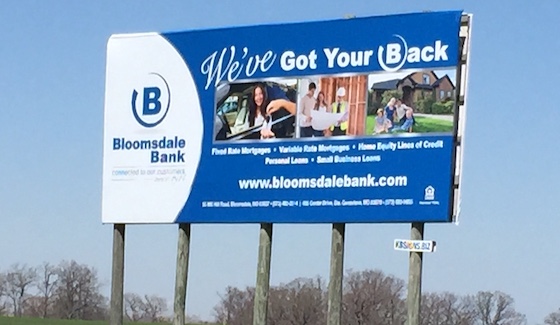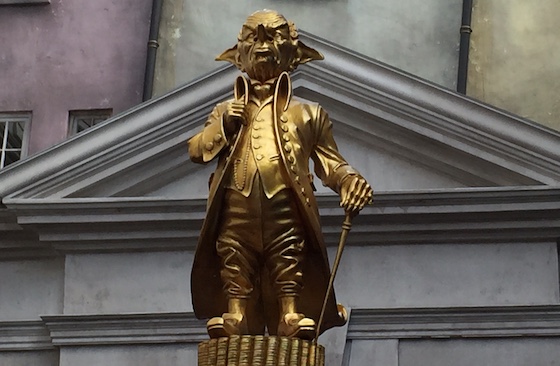Memo From Frank
The City of Detroit recently began writing a new sign ordinance to allow billboards to go back up in the central business district, after being forcibly removed a short while ago. Why the change of heart? It's because - contrary to what non-profit groups might argue - billboards add an aura of excitement and needed information to cities. When you visit metropolitan areas that have no billboards, due to full moratoriums and aggressive enforcement, they appear sterile ad uninviting. There is a unique relationship in America between vitality and billboard advertisements. From Times Square to the LA Freeway, prosperity and excitement is represented in billboard signs. Detroit learned this lesson the hard way, by removing the one thing that made the downtown area seem vital and alive. The billboards won and will now return.
Is This What Your Financial Security Looks Like?

Most people pass these simple wooden billboards and never think twice. But savvy investors look at this as one of America's best business models. Wooden signs have been around for over a hundred years. And the industry has changed little over that time. If you ignore these signs, you may be missing out on your future financial security.
Here's how the numbers work
A standard wooden billboard has two advertising faces. They would typically rent for $2,000 per year, net of production cost. The total costs are about $1,000 per year. So the net income is about $3,000 per year for that unit. It costs about $6,000 to build that sign, so it's a two-year payback. And then it's $3,000 of cash flow per year going forward. That's just for one sign. Now multiply that by 10, 20 or 30. You could literally make about $100,000 per year with just 30 of these wooden signs.
Here's what your time commitment would look like
To rent one billboard requires the following. A list of prospects (namely businesses located in that same direction as the ad), a phone number on the sign, and a flyer to mail out to those prospects. Often, the customer calls you and rents it. Otherwise you have to call all of the prospects and get it rented. But this only happens one time per year per billboard ad face. And you can often get a high renewal rate (I always maintained around 80% renewal rates). That means that you can operate 10, 20 or 30 of these wooden signs with very little time. On top of that, there's little management effort other than renting ad space, as these signs are not lighted and there's nothing to break.
Here's what the future could look like
If you built just 6 signs, you could generate $18,000 per year in cash flow after two years. That cash flow would pay for 6 additional signs to be built each year after that. Within 6 years you'd own 30 of these wooden billboards free and clear, with a positive cash flow per year of around $100,000. Imagine how a second stream of income of $100,000 per year would change your life.
Conclusion
Wooden billboards have one of the best business models on earth. Most people drive by them and never had any idea of what the potential is. Now you do.
The Ultimate Billboard Boot Camp
![]() How to Find a Billboard Location
How to Find a Billboard Location
![]() How to Buy a Billboard
How to Buy a Billboard
![]() How to Build a Billboard
How to Build a Billboard
![]() How to Operate a Billboard
How to Operate a Billboard
![]() How to Rent Ad Space on a Billboard
How to Rent Ad Space on a Billboard
![]() How to Sell a Billboard
How to Sell a Billboard
Get Your Copy Now!
How Can You Get Capital To Build Billboards?

So you want to get into the billboard business. Where do you get the capital to get started? What are the options? Well, there are a number of potential sources to consider.
SDIRA
Also known as a "self-directed IRA", this is when you convert a standard IRA into an instrument that allows you to invest in many alternative options, such as billboards (although you can't invest with art or other barred categories). The largest provider of SDIRAs in the U.S. is Equity Trust, and they can give you a complete overview and the process costs around $500.
Friends and family
Many people start their billboard business using private investments from friends and family, Let's say that you want to build a wooden billboard for $6,000. Your family member might loan you $6,000 at 10% interest, and you pay them back in two years with 10% interest the whole time. That's a win/win for them and you. There are many people out there that are unhappy with their current investment performance who will be willing to take a chance on you. And you are probably related to some of them.
Banks
Although the prospect of asking for money from a bank may seem scary, it's how many billboard careers began. It's really not as awkward as it seems, as long as you believe in what you're doing. Banks are businesses and they have to lend money to make money. One of the biggest problems in getting bank loans for billboards are 1) they don't really understand the business and 2) the loan amounts are relatively small and, as a result, it's hard to get them interested in learning. My banking began when I found a bank that would do just one initial sign as a test, and then another and another.
Hard-money lenders
There are lenders that are not part of the banking world but can be just individuals or groups that finance things at a specified interest rate. The biggest problem with these groups are that they often have really high interest rates, or a "loan to own" mentality in which they actually hope you fail so they can take the sign from you (unlike a bank that never wants to foreclose if they don't have to).
Small business loans
The Small Business Administration is a division of the U.S. government. They make SBA loans under certain circumstances that you might fit the criteria of. Contact the SBA for more information and to see if this type of lending applies to your circumstances.
Lines of credit
This could be from any source, and is collateralized or non-collateralized in nature. They have variable rates of interest, and be sure that you fully understand what that rate is (for example, some credit card loans start off low at 5% but then rise to 20% over time).
How to be in the business with zero capital and still prosper
If you don't want to borrow money, there's still one option that does not even require a penny of capital. There's the simple business model of obtaining leases and permits and selling those to other billboard companies. Some individuals simply flip leases and never build or own a sign of their own.
Conclusion
Although it may seem difficult on the surface, there are actually quite a few avenues to obtain capital to build billboards. All of them are a win/win business model.
A Primer On How To Keep This From Happening To Your Sign

There's nothing worse for a billboard than to have its visibility blocked. It can take a winning sign into a vacant sign, and a great investment into a total loser. So if clear visibility is so important, how can you ensure that your sign will always be able to be seen by motorists?
Plan ahead - like a decade or more
Smart billboard owners always think ahead - about a decade ahead. You always want to think about risks to your sign's visibility going forward. How tall will those trees grow? Will that property next door be developed some day and, if so, how tall will the building be? What if they build their own premise sign? You can never be too cautious when it comes to sign visibility. It's been my experience that virtually every sign blockage that you see on the road today could have been avoided with better foresight years earlier.
Build signs that are high enough to clear obstructions
The first way to avoid obstructions is simply to place your sign well above them. If you think that the trees will grow 10' taller over the years, then build your sign 15' above the trees now. Some people are always thinking "how low can I build the sign to cut costs" but the truth is that the few thousand dollars you'll save by going shorter will be erased in month of future vacancy.
Flag them effectively
Before you build any sign, you need to "flag" the sign to see what the potential blockage might be. This entails raising a flag to the proposed height of the sign and seeing how it relates to potential obstacles. I flagged every locations I ever built except one. I assumed that the sign was clear of obstructions and didn't need to bother measuring it. That was the worst mistake of all time. I had failed to take into account the roof line of the church next door, and the sign was built with partial blockage already in front of it.
Forge a vegetation agreement
If you can't build above the trees, another option is to forge a "vegetation agreement" with the neighboring property owner that gives you the ability to trim back trees in return for an annual payment. If you want to enter into such an agreement, you have to do it before you build the sign. After you've built it, it will be obvious to the neighbor that they have you over a barrel and the price will go up ten-fold.
But never just cut it down without permission
One thing you must never do - regardless of the circumstances - is just to sneak into the neighbor's property and cut down the tree that's blocking you. That might be a felony. The punishment could be severe. I know of a sign owner who did that once, and they were fined $10,000 and spent another $10,000 in legal cost. You must cure obstructions legally.
Conclusion
Think ahead and keep obstructions off your sign. A visible sign is a happy sign and a happy advertiser. Don't let encroachments happen.
